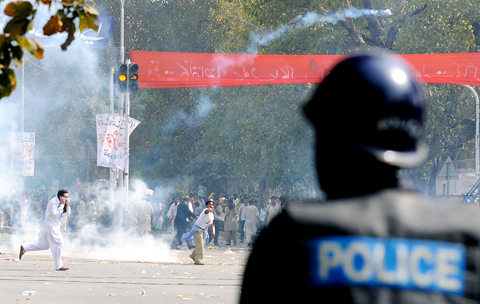Police fought running battles with stone-throwing anti-government protesters yesterday after authorities tried to detain opposition leader Nawaz Sharif, fanning a crisis that has alarmed the US.
Sharif is locked in a power struggle with the Pakistani president that threatens to paralyze politics in the nuclear-armed country and dilute its focus on tackling economic woes as well as Taliban militants operating along the Afghan border.
Hundreds of police surrounded the former prime minister’s residence in the eastern city of Lahore before dawn and detained him along with scores of his supporters, a party spokesman said.

PHOTO: AFP
Officers showed party officials an order placing Sharif and his politician brother, Shahbaz, under house arrest for three days, spokesman Pervaiz Rasheed said.
But Sharif later denounced the order as illegal and left the house in a convoy of vehicles packed with chanting, flag-waving supporters, headed for a downtown rally that had already turned violent.
“These are the decisive moments,” Sharif told supporters before climbing into a car. “I tell every Pakistani youth that this is not the time to stay home; Pakistan is calling you to come and save me.”
Rao Iftikhar, a senior government official, said authorities had decided to relax restrictions on Sharif so that he could address the rally and return home.
Lawyers and opposition party supporters had planned to gather near Lahore’s main court complex before heading toward Islamabad to stage a mass sit-in front of Parliament, in defiance of a ban.
To thwart them, authorities parked trucks across major roads on the edge of the city and riot police took up positions outside the railway station and government buildings.
Still, thousands of flag-waving demonstrators pushed past police barricades to reach the courts.
Protesters pelted some of the hundreds of riot police ringing the area with rocks, triggering running clashes. A reporter saw one officer led away with a head wound.
Police repeatedly fired tear gas, scattering the crowd, and beat several stragglers with batons, only for the demonstrators to return with fresh supplies or sticks and stones.
Mobs accompanying Sharif’s swelling convoy smashed the windows of buses parked along the route. Others set fire to tires, sending plumes of black smoke into the blue sky over a usually bustling boulevard littered with stones and empty tear gas shells.
Shahbaz Sharif and a host of other protest leaders went underground to dodge detention orders. Iftikhar said they included the head of Pakistan’s main Islamist party and cricketer star-turned-politician Imran Khan.
TV images showed police commandos wearing flak jackets and armed with assault rifles apparently searching for Shahbaz in Rawalpindi, just south of the capital.
Shahbaz, speaking to Geo TV by telephone, appealed to Pakistanis to come out onto the streets.
“[President Asif Ali] Zardari has put the nation into this deep crisis by breaking his promises,” he said. “These fascist tactics cannot stop the masses who want justice.”
Washington worries that the crisis is preventing the government from being an effective ally in the fight against insurgents in Afghanistan and is encouraging both sides to compromise.
Suspected militants attacked a transport terminal in northwestern Pakistan used to supply NATO troops in Afghanistan before dawn yesterday and torched dozens of containers and military vehicles, police said.

The CIA has a message for Chinese government officials worried about their place in Chinese President Xi Jinping’s (習近平) government: Come work with us. The agency released two Mandarin-language videos on social media on Thursday inviting disgruntled officials to contact the CIA. The recruitment videos posted on YouTube and X racked up more than 5 million views combined in their first day. The outreach comes as CIA Director John Ratcliffe has vowed to boost the agency’s use of intelligence from human sources and its focus on China, which has recently targeted US officials with its own espionage operations. The videos are “aimed at

STEADFAST FRIEND: The bills encourage increased Taiwan-US engagement and address China’s distortion of UN Resolution 2758 to isolate Taiwan internationally The Presidential Office yesterday thanked the US House of Representatives for unanimously passing two Taiwan-related bills highlighting its solid support for Taiwan’s democracy and global participation, and for deepening bilateral relations. One of the bills, the Taiwan Assurance Implementation Act, requires the US Department of State to periodically review its guidelines for engagement with Taiwan, and report to the US Congress on the guidelines and plans to lift self-imposed limitations on US-Taiwan engagement. The other bill is the Taiwan International Solidarity Act, which clarifies that UN Resolution 2758 does not address the issue of the representation of Taiwan or its people in

US Indo-Pacific Commander Admiral Samuel Paparo on Friday expressed concern over the rate at which China is diversifying its military exercises, the Financial Times (FT) reported on Saturday. “The rates of change on the depth and breadth of their exercises is the one non-linear effect that I’ve seen in the last year that wakes me up at night or keeps me up at night,” Paparo was quoted by FT as saying while attending the annual Sedona Forum at the McCain Institute in Arizona. Paparo also expressed concern over the speed with which China was expanding its military. While the US

SHIFT: Taiwan’s better-than-expected first-quarter GDP and signs of weakness in the US have driven global capital back to emerging markets, the central bank head said The central bank yesterday blamed market speculation for the steep rise in the local currency, and urged exporters and financial institutions to stay calm and stop panic sell-offs to avoid hurting their own profitability. The nation’s top monetary policymaker said that it would step in, if necessary, to maintain order and stability in the foreign exchange market. The remarks came as the NT dollar yesterday closed up NT$0.919 to NT$30.145 against the US dollar in Taipei trading, after rising as high as NT$29.59 in intraday trading. The local currency has surged 5.85 percent against the greenback over the past two sessions, central